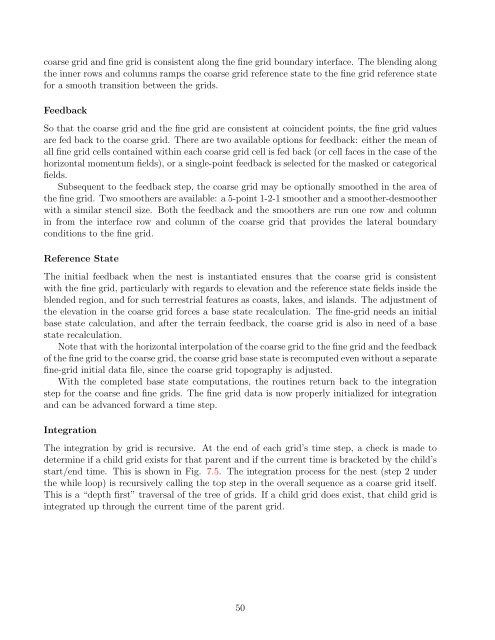Advanced Research WRF (ARW) Technical Note - MMM - University ...
Advanced Research WRF (ARW) Technical Note - MMM - University ...
Advanced Research WRF (ARW) Technical Note - MMM - University ...
Create successful ePaper yourself
Turn your PDF publications into a flip-book with our unique Google optimized e-Paper software.
coarse grid and fine grid is consistent along the fine grid boundary interface. The blending along<br />
the inner rows and columns ramps the coarse grid reference state to the fine grid reference state<br />
for a smooth transition between the grids.<br />
Feedback<br />
So that the coarse grid and the fine grid are consistent at coincident points, the fine grid values<br />
are fed back to the coarse grid. There are two available options for feedback: either the mean of<br />
all fine grid cells contained within each coarse grid cell is fed back (or cell faces in the case of the<br />
horizontal momentum fields), or a single-point feedback is selected for the masked or categorical<br />
fields.<br />
Subsequent to the feedback step, the coarse grid may be optionally smoothed in the area of<br />
the fine grid. Two smoothers are available: a 5-point 1-2-1 smoother and a smoother-desmoother<br />
with a similar stencil size. Both the feedback and the smoothers are run one row and column<br />
in from the interface row and column of the coarse grid that provides the lateral boundary<br />
conditions to the fine grid.<br />
Reference State<br />
The initial feedback when the nest is instantiated ensures that the coarse grid is consistent<br />
with the fine grid, particularly with regards to elevation and the reference state fields inside the<br />
blended region, and for such terrestrial features as coasts, lakes, and islands. The adjustment of<br />
the elevation in the coarse grid forces a base state recalculation. The fine-grid needs an initial<br />
base state calculation, and after the terrain feedback, the coarse grid is also in need of a base<br />
state recalculation.<br />
<strong>Note</strong> that with the horizontal interpolation of the coarse grid to the fine grid and the feedback<br />
of the fine grid to the coarse grid, the coarse grid base state is recomputed even without a separate<br />
fine-grid initial data file, since the coarse grid topography is adjusted.<br />
With the completed base state computations, the routines return back to the integration<br />
step for the coarse and fine grids. The fine grid data is now properly initialized for integration<br />
and can be advanced forward a time step.<br />
Integration<br />
The integration by grid is recursive. At the end of each grid’s time step, a check is made to<br />
determine if a child grid exists for that parent and if the current time is bracketed by the child’s<br />
start/end time. This is shown in Fig. 7.5. The integration process for the nest (step 2 under<br />
the while loop) is recursively calling the top step in the overall sequence as a coarse grid itself.<br />
This is a “depth first” traversal of the tree of grids. If a child grid does exist, that child grid is<br />
integrated up through the current time of the parent grid.<br />
50
















